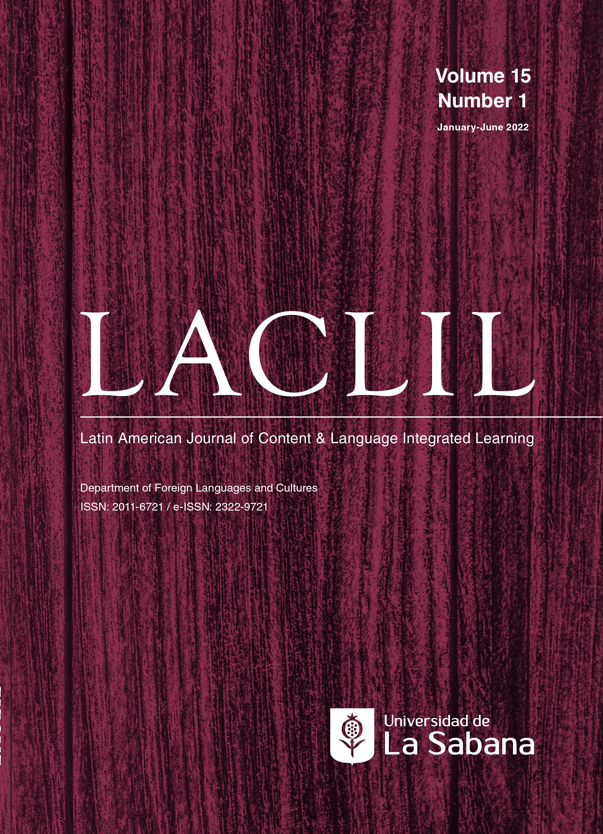Student and Teacher Perspectives on Co-created CLIL-Appropriate Materials Focused on Critical Thinking and Active Citizenship
DOI:
https://doi.org/10.5294/laclil.2022.15.1.2Keywords:
21st-century skills, active citizenship, CLIL materials, civic engagement, student-centeredAbstract
The International Relations English program at a university in the north of Colombia is a CLIL-based program. Students share an interest in issues related to rights and politics, both locally and globally. Colombia arrived at a historical juncture with the signing of the peace accords between the government and FARC guerrillas in 2016. However, this coincided with an extreme polarisation of political discourse. This polarisation was evident throughout the 2016 plebiscite on the peace agreements and further intensified in the build-up to the 2018 presidential elections. In response, teachers and students created a web series where students outlined the candidates’ critical proposals without revealing the candidates’ identities. Students researched the proposals and worked with a teacher to prepare English transcripts of the proposals. Eight videos were created, shared via social media, and made available to local English teachers at secondary and university levels. The project’s purpose was to encourage active citizenship and foment a more critical analysis of the candidates’ proposals. To achieve this, students utilised the anonymity of the candidates and English as the chief medium of communication. This project allowed teachers to use authentic and relevant student-generated materials to encourage more critical discussion. The students involved in the project reported feelings of political efficacy and civic engagement. Teachers expressed satisfaction at having contextually rich language materials. This project indicates the potential for student-generated materials to provide contextually relevant and highly motivating educational materials.
Downloads
References
Ball, P. (2018). Innovations and Challenges in CLIL Materials Design, Theory into Practice. https://doi.org/10.1080/00405841.2018.1484036
Banegas, D. L. (2017). Teacher-developed materials for CLIL: Frameworks, sources, and activities. Asian EFL Journal, 19(3), 31–48. https://www.elejournals.com/asian-efl-journal/the-asian-efl-journal-quarterly-september-2017/
Banegas, D., & Del Pozo Beamud, M. (2020). Content and Language Integrated Learning: A Duo-ethnographic Study about CLIL In-service Teacher Education in Argentina and Spain. Regional Language Centre (RELC) Journal, 1(14). https://doi.org/10.1177/0033688220930442
Breuing, M. (2011). Problematizing Critical Pedagogy. The International Journal of Critical Pedagogy, 3.
Broom, C. (2015). Empowering Students: Pedagogy which benefits educators and learners, Citizenship, Social and Economics Education Volume, 14(2), 79-86. https://doi.org/10.1177/2047173415597142
Chun, C. (2010). Discourse Itineraries in an EAP Classroom: A Collaborative Critical Literacy Praxis [unpublished doctoral dissertation, University of Toronto].
Contreras León, J. J., & Chapetón Castro, C. M. (2017). Transforming EFL classroom practices and promoting students’ empowerment: Collaborative learning from a dialogical approach. PROFILE Issues in Teachers’ Professional Development, 19(2), 135-149. http://dx.doi.org/10.15446/profile.v19n2.57811.
Copley, K. (2018). Neoliberalism and ELT Coursebook Content. Critical Inquiry in Language Studies, 15(1), 43-62. https://doi.org/10.1080/15427587.2017.1318664
Dylman, A. S., & Bjärtå, A. (2019). When your heart is in your mouth: the effect of second language use on negative emotions. Cognition and Emotion, 33(6), 1284-1290. https://doi.org/10.1080/02699931.2018.1540403
Freire, P. (1972). Pedagogy of the Oppressed. Penguin Random House.
Gilmore, A. (2007). Authentic Materials & Authenticity in Foreign Language Learning. Language Teaching, 40, 97-118. https://doi.org/10.1017/S0261444807004144
Giroux, H. (2010). Rethinking Education as the Practice of Freedom: Paolo Freire and the promise of Critical Pedagogy. Policy Futures in Education, 8(6). https://doi.org/10.2304/pfie.2010.8.6.715
Keysar, B., Hayakawa, S. L., & An, S. G. (2012). The foreign-language effect: Thinking in a foreign tongue reduces decision biases. Psychological Science, 23, 661–668. https://doi.org/10.1177/0956797611432178
King, N. (2004). Using templates in the thematic analysis of text. In C. Cassell & G. Symon, (Eds.), Essential guide to qualitative methods in organizational research (pp. 257–270). Sage
Kubota, R., & Miller, E. R. (2017). Re-examining and re-envisioning criticality in language studies: Theories and praxis. Critical Inquiry in Language Studies, 14, 129-157. https://doi.org/10.1080/15427587.2017.1290500
Mehisto, P. (2012). Criteria for Producing CLIL Learning Material, Encuentro 21/2012, 15-33. ISSN 1989-0796
Meyer, O. (2010). Towards quality CLIL: Successful Planning and Teaching Strategies. Pulso, 33, 11-29. ISSN 1577-0338
Moiseenko, V. (2015). Encouraging Learners to make Language Learning Materials. English Teaching Forum. https://americanenglish.state.gov/files/ae/resource_files/veronika_moiseenko_encouraging_learners_to_create_language-learning_materials.pdf
Nowell, L. S., Norris J. M., White, D. E., & Moules, N. J. (2017). Thematic Analysis: Striving to Meet the Trustworthiness Criteria. International Journal of Qualitative Methods, 16(1). https://doi.org/10.1177/1609406917733847
Pennycook, A. (1999). Introduction: Critical Approaches to TESOL. TESOL Quarterly, 33(3), 329–348. https://doi.org/10.2307/3587668
Pinner, R. (2016). The nature of authenticity in English as a foreign language: A comparison of eight inter-related definitions. ELTWO Journal, 9(1), 78-93.
Sen, A. (1999). Development as Freedom. Oxford University Press.
Downloads
Published
How to Cite
Issue
Section
License
Copyright (c) 2022 Latin American Journal of Content & Language Integrated Learning

This work is licensed under a Creative Commons Attribution-NonCommercial-NoDerivatives 4.0 International License.
This Journal and its articles are published under the Creative Commons CC BY 4.0 DEED Attribution 4.0 International license. You are free to: Share — copy and redistribute the material in any medium or format for any purpose, even commercially. Adapt — remix, transform, and build upon the material for any purpose, even commercially. The license cannot revoke these freedoms as long as you follow the terms of the license.








